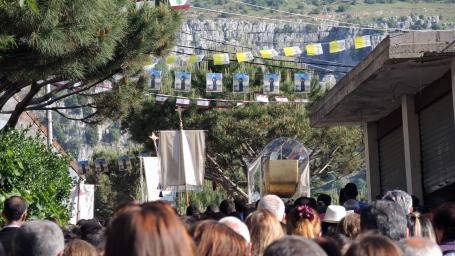I spent the final class session reprising a brainstorm exercise that I had used at the beginning of the semester.1 My students’ comments were exciting; they named for themselves what they had learned over the course of the semester.
We began the semester with a brainstorm of words that my students associated with the two terms in the title of this course: “Global” and “Catholicism.” When I mentioned that we would be reprising this exercise, some of my students reached for their computers so they could read the original lists. I asked them to hold off, though. I sensed that if they had the first lists right in front of them, they might be tempted to approach this second version of the brainstorm with the goal of correcting themselves, getting the lists right, adding to them, and so on. Instead, I wanted them to generate the second versions of the lists in a manner that allowed them to be surprised by the experience, and thus prompted to reflect in an unvarnished manner about the experience of reading and reflecting on the lives of Catholics around the world.
Some of the terms for “global” that my students came up with during the first week of class were:
Earth
Oceans
Language
Population
Hemisphere
The second version of the “global” list, the one my students generated at the end of the semester, included a number of new terms:
Change
Movements
Immigration
Catholicism
Same/Different
But it was the qualities of the terms in the second version of this brainstorm that caught my students’ attention. According to one student, the terms in the second version were much more “general” and “abstract.” In January, the terms had reflected things that were more “concrete” or “definite.” He added, “These are things that you would find on a map. Like, an actual hemisphere.” Now, in contrast, global is much more about things that “change” or “move.” “We’re talking about processes now,” he concluded. It seemed that one of the things my students had gained from the class was a more abstract view of what counts as global.
The list under “Catholicism” was even more different. My students had initially mentioned the following:
Church
Priest
Homily
Baptism
Diocese
Now, they included terms like:
Exorcism
The Virgin Mary
Charismatics
Nuns
Development
Their comments about these terms, in the words of another student, reflected a change in the place where Catholicism takes place. “Before, we talked about the things you would see if you walked into a church. Now, it’s like people practice Catholicism in a lot of different places, not just inside a church. In their everyday lives.” Another student then jumped in, “It’s lived Catholicism.”
This was a term that I introduced at the beginning of the semester. If I had any success in teaching this course, it was nice to see that my students were now able to describe what this term meant to them. What also struck me about this exchange was the way my students had interpreted lived Catholicism in terms of place: Catholicism that happens in a church versus Catholicism that happens outside, somewhere else, in everyday life. In the Catholics & Cultures program, we talk about Catholicism in its pragmatic dimensions, and we are interested in the variety of ways people put their faith to use. It is interesting to see that my students understood lived Catholicism also in terms of place.
Finally, I felt that this exercise was successful because it allowed students to place before themselves, using their own words, what they had learned. At the same time, the lists were not entirely their own; they were collective creations. The comments about the differences between the two lists were comments about a journey the class had made collectively. This seemed to counteract the tendency for learning evaluations to individualize students insofar as college anti-collaboration policies encourage them to work alone and turn in their own assignments. I’m also aware that there might have been limitations to this exercise: it gave the impression that students should see the class as a journey or a transformation, for instance. Did some of my students feel like they did not progress or perhaps chafed against the expectation that they should become different somehow over the course of the semester? For whatever reason, I am sure that some of my students might have also felt left out by this exercise because of this built-in assumption.
